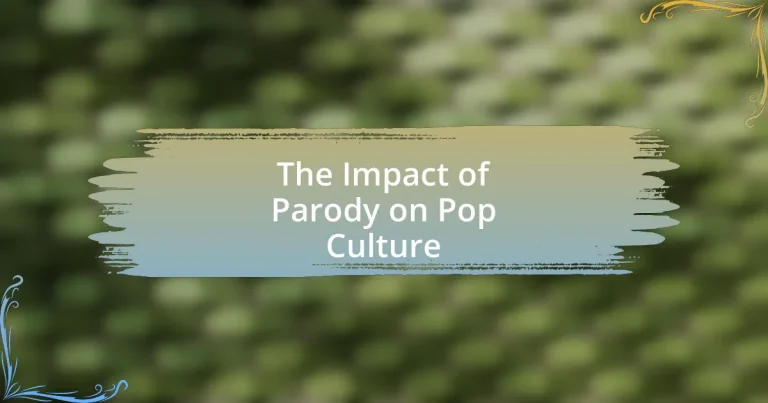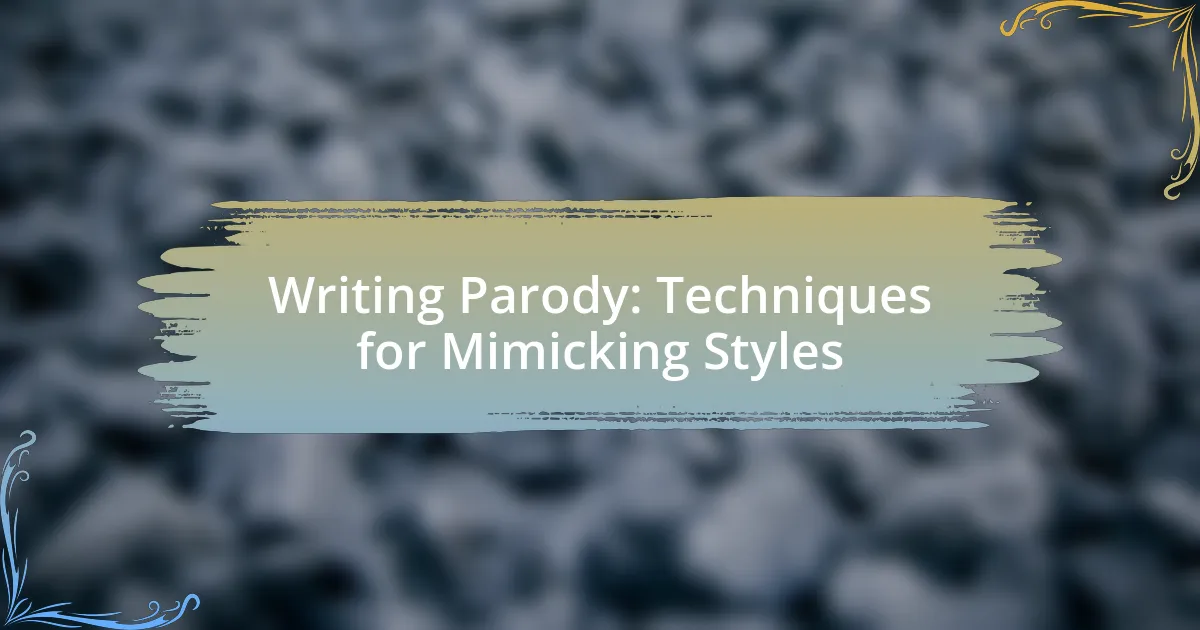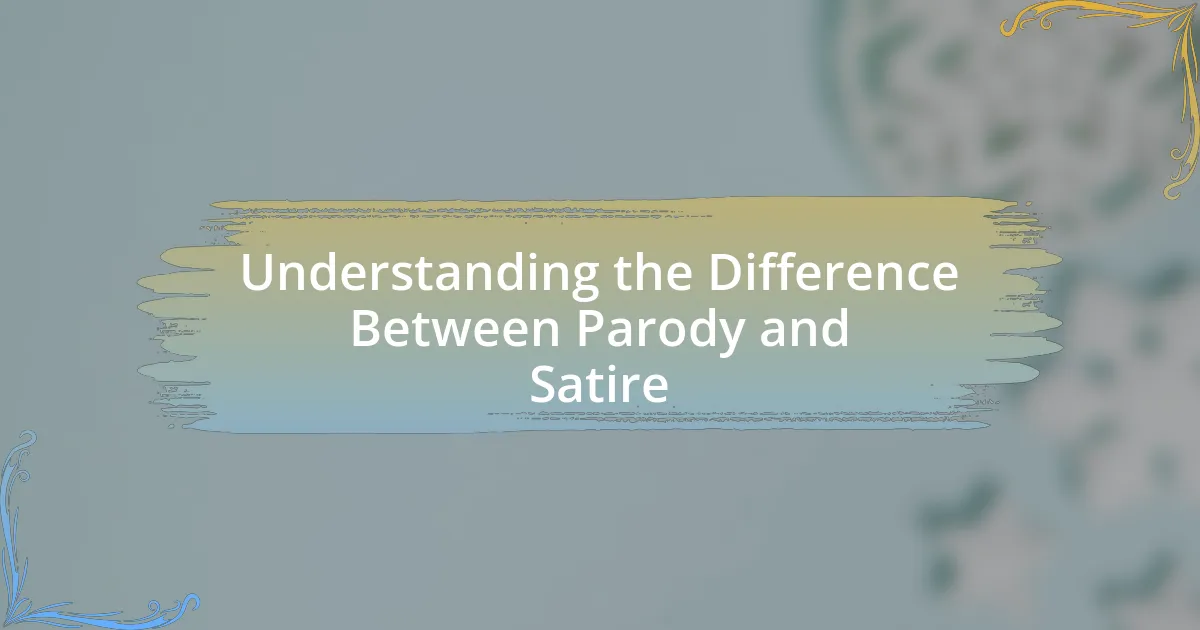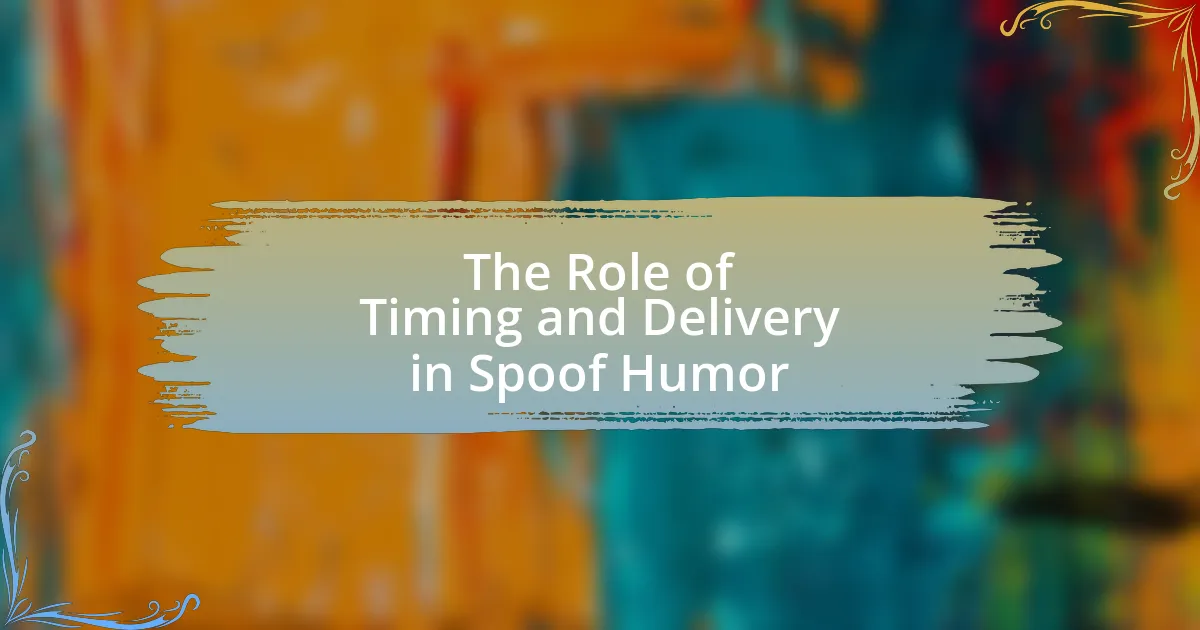Parody plays a crucial role in shaping pop culture by critiquing societal norms, trends, and media through humor and exaggeration. It influences public discourse by challenging traditional narratives and encouraging critical thinking about cultural practices and beliefs. Key elements of parody, such as humor and cultural references, resonate with audiences, fostering community and engagement. Various forms of parody, including television, film, music, and social media, serve as tools for social commentary, while also impacting audience perception and encouraging dialogue around important issues. The article explores the significance of parody in contemporary culture, its psychological effects on viewers, and the ethical considerations creators should keep in mind when crafting parodic content.
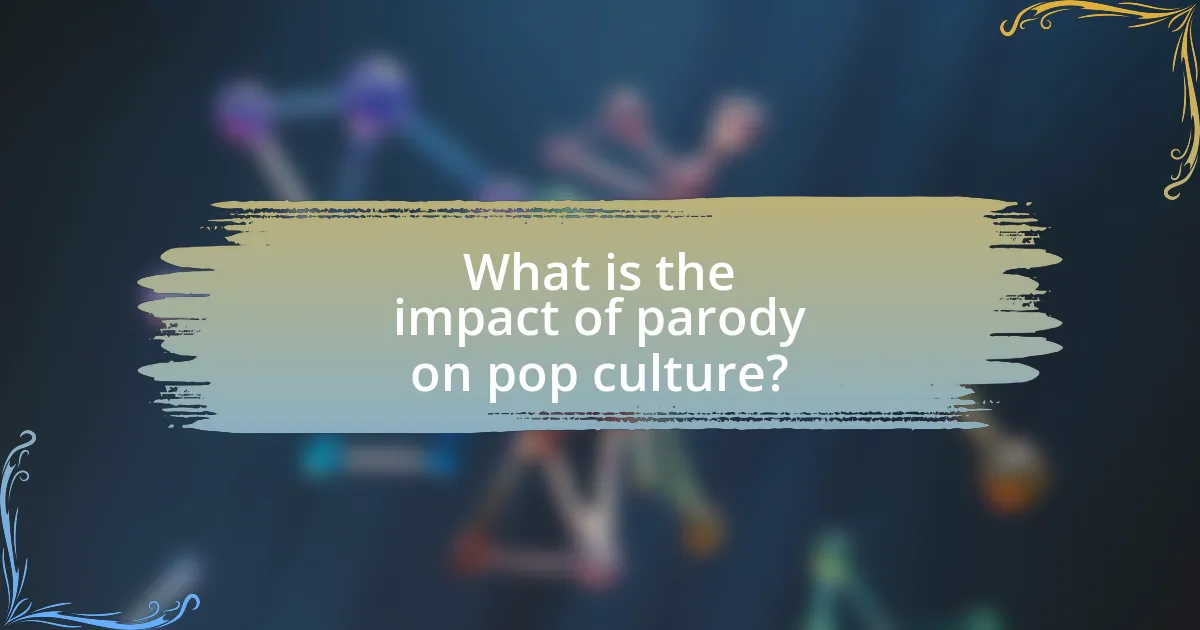
What is the impact of parody on pop culture?
Parody significantly influences pop culture by providing a lens through which societal norms, trends, and media can be critiqued and reinterpreted. This form of expression often highlights absurdities in popular media, prompting audiences to reflect on the original content and its cultural implications. For instance, shows like “Saturday Night Live” and “The Simpsons” have utilized parody to comment on political events and social issues, shaping public discourse and influencing perceptions. Research indicates that parody can enhance audience engagement by fostering a sense of community among viewers who share an understanding of the references being made, thus reinforcing its role as a vital component of contemporary pop culture.
How does parody influence societal norms and values?
Parody influences societal norms and values by providing a critical lens through which cultural practices and beliefs can be examined and challenged. By exaggerating and mocking established norms, parody encourages audiences to question the validity and relevance of those norms, often leading to shifts in public perception. For instance, television shows like “Saturday Night Live” have historically used parody to address political issues, shaping viewers’ opinions and prompting discussions about governance and social justice. This form of satire can lead to increased awareness and, ultimately, changes in societal values, as seen in the way parody has influenced movements such as feminism and LGBTQ+ rights by highlighting absurdities in traditional gender roles and stereotypes.
What are the key elements of parody that resonate with audiences?
The key elements of parody that resonate with audiences include humor, exaggeration, and cultural references. Humor in parody often arises from the clever imitation of original works, allowing audiences to appreciate the absurdity of the source material. Exaggeration amplifies specific traits or themes, making them more recognizable and entertaining, which engages viewers by highlighting the ridiculousness of the original context. Cultural references ground the parody in familiar societal norms or popular media, enabling audiences to connect with the content on a deeper level. For instance, the success of “Weird Al” Yankovic’s song parodies demonstrates how these elements effectively engage listeners by transforming well-known songs into humorous critiques of contemporary culture.
How does parody challenge traditional media narratives?
Parody challenges traditional media narratives by subverting established norms and conventions, often highlighting their absurdities. Through exaggeration and humor, parody exposes biases, stereotypes, and inconsistencies within mainstream media, prompting audiences to question the validity of the narratives presented. For example, shows like “Saturday Night Live” and “The Daily Show” utilize parody to critique political figures and media coverage, effectively reshaping public perception and discourse. This form of media not only entertains but also encourages critical thinking, as evidenced by studies showing that audiences who engage with parody are more likely to recognize media bias and misinformation.
Why is parody significant in contemporary culture?
Parody is significant in contemporary culture because it serves as a critical tool for social commentary and cultural reflection. By mimicking and exaggerating existing works, parody allows creators to highlight societal norms, challenge authority, and provoke thought among audiences. For instance, shows like “Saturday Night Live” and “The Simpsons” utilize parody to address political issues and cultural phenomena, influencing public opinion and sparking conversations. This form of expression not only entertains but also encourages audiences to question the status quo, making parody a vital component of cultural discourse today.
What role does parody play in shaping public discourse?
Parody plays a significant role in shaping public discourse by providing a critical lens through which societal norms, political issues, and cultural phenomena can be examined and challenged. It allows individuals to engage with complex topics in a more accessible and humorous manner, often highlighting absurdities and contradictions within mainstream narratives. For instance, shows like “Saturday Night Live” and “The Onion” use parody to critique political figures and policies, influencing public opinion and sparking conversations around important issues. Research indicates that parody can enhance political engagement by making discussions more relatable and entertaining, thereby encouraging audiences to reflect on their beliefs and the status quo.
How does parody contribute to the evolution of artistic expression?
Parody contributes to the evolution of artistic expression by serving as a critical lens through which existing works are reinterpreted and challenged. This form of artistic commentary allows creators to highlight societal norms, cultural trends, and artistic conventions, often leading to innovation and new genres. For instance, the rise of parody in literature and film, such as in works like “Don Quixote” or “Scary Movie,” demonstrates how parody can deconstruct established narratives and styles, prompting audiences to reconsider their perceptions of the original works. By engaging with and subverting these conventions, parody not only entertains but also fosters dialogue about the nature of art itself, thus driving its evolution.
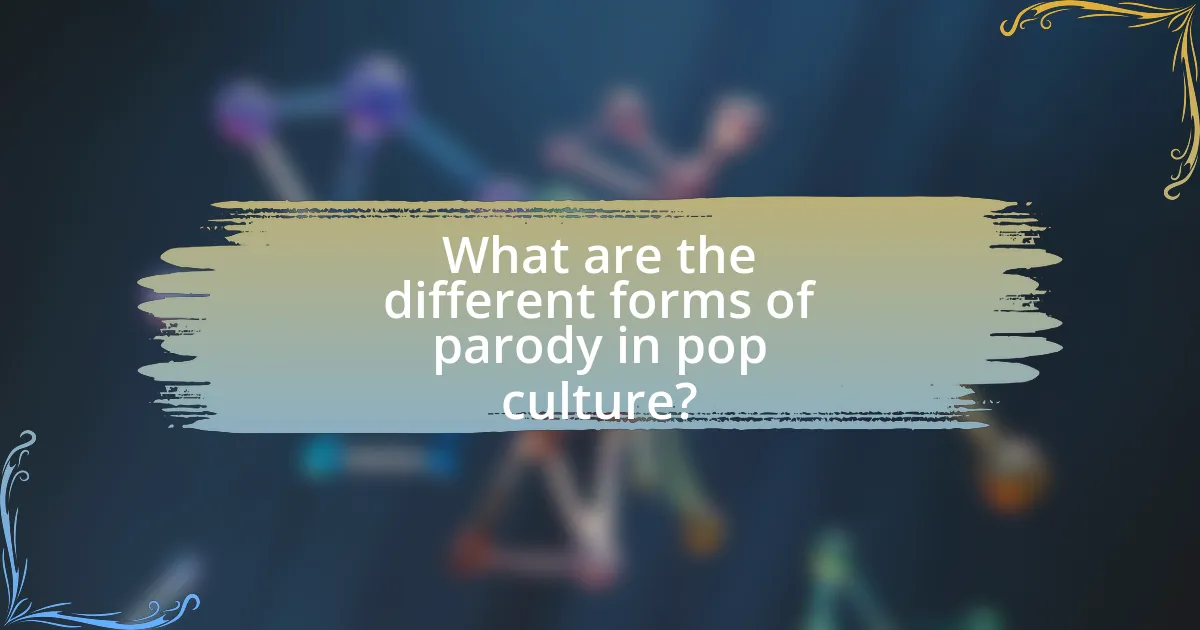
What are the different forms of parody in pop culture?
Different forms of parody in pop culture include film, television, literature, music, and social media. In film, examples like “Scary Movie” and “Airplane!” mimic and exaggerate established genres, creating humor through absurdity. Television shows such as “Saturday Night Live” and “The Simpsons” often parody current events and popular culture, using satire to critique societal norms. In literature, works like “Pride and Prejudice and Zombies” blend classic narratives with modern twists, highlighting the original text’s conventions. Music parodies, exemplified by “Weird Al” Yankovic, transform popular songs into humorous versions that comment on contemporary issues. Social media platforms also facilitate parody through memes, where users create humorous content that references and mocks cultural phenomena. Each of these forms serves to entertain while providing commentary on the original subjects, reinforcing the role of parody as a significant element in pop culture.
How do various media utilize parody?
Various media utilize parody as a tool to critique, satirize, or comment on cultural phenomena, often by mimicking the style or content of the original work. For example, television shows like “Saturday Night Live” and “The Simpsons” employ parody to address political events and societal norms, using humor to provoke thought and discussion among audiences. Additionally, films such as “Scary Movie” and “Airplane!” parody specific genres, highlighting their clichés and tropes, which not only entertains but also encourages viewers to reflect on the conventions of those genres. This use of parody in media serves to both entertain and engage audiences, making them more aware of the underlying messages and societal issues present in popular culture.
What are the characteristics of parody in film and television?
Parody in film and television is characterized by its humorous imitation of existing works, often exaggerating their features to create comedic effect. This form of satire typically employs recognizable tropes, clichés, and styles from the original material, allowing audiences to identify the source being parodied. For instance, films like “Scary Movie” and television shows such as “Saturday Night Live” utilize parody by mimicking popular horror films and current events, respectively, to critique or entertain. The effectiveness of parody relies on the audience’s familiarity with the original content, which enhances the comedic impact and commentary on societal norms or cultural phenomena.
How does music parody differ from other forms?
Music parody differs from other forms by specifically imitating and humorously exaggerating the style and content of existing songs, often to critique or comment on cultural phenomena. Unlike general parody, which can encompass various media, music parody focuses on musical elements such as melody, rhythm, and lyrics, creating a unique blend of humor and musicality. For instance, “Weird Al” Yankovic is renowned for his music parodies, transforming popular songs into comedic versions that reflect societal issues or trends, thereby engaging audiences in a way that traditional satire may not achieve. This distinct approach allows music parody to resonate deeply within pop culture, as it leverages familiar tunes to deliver its message effectively.
What are some notable examples of parody in pop culture?
Notable examples of parody in pop culture include “The Simpsons,” which satirizes American family life and societal norms, and “Weird Al” Yankovic’s music, which humorously reinterprets popular songs. “The Simpsons” has been influential since its debut in 1989, using humor to critique various aspects of culture and politics, while “Weird Al” has released over 14 studio albums, showcasing his ability to blend comedy with music. Additionally, the film “Scary Movie” parodies the horror genre, specifically targeting films like “Scream” and “I Know What You Did Last Summer,” contributing to the success of parody films in the early 2000s. These examples illustrate how parody serves as a tool for social commentary and entertainment in pop culture.
How have specific parodies influenced popular trends?
Specific parodies have significantly influenced popular trends by shaping cultural conversations and altering consumer behavior. For example, “Weird Al” Yankovic’s parodies of popular songs have not only garnered commercial success but also sparked trends in music and humor, leading to increased interest in the original songs and artists. Additionally, the “Saturday Night Live” sketches that parody political figures have impacted public perception and engagement in politics, as seen during election cycles where such parodies drive social media discussions and voter turnout. These instances demonstrate how parodies can create ripple effects in entertainment and societal attitudes, reinforcing their role in shaping popular culture.
What impact did iconic parodies have on their original subjects?
Iconic parodies significantly influence their original subjects by reshaping public perception and often enhancing the visibility of the original works. For instance, the film “Scary Movie” parodied the horror genre, leading to increased interest in the original films it spoofed, such as “Scream” and “The Sixth Sense.” This phenomenon occurs because parodies can highlight the absurdities or clichés within the original works, prompting audiences to revisit them with a new perspective. Additionally, parodies can create a cultural dialogue around the original subjects, as seen with “The Simpsons,” which satirizes various aspects of American life, thereby prompting discussions about societal norms and values.

How does parody affect audience perception and engagement?
Parody significantly influences audience perception and engagement by providing a humorous critique of cultural norms and media. This comedic approach allows audiences to reflect on the original material, often leading to increased awareness and critical thinking about societal issues. Research indicates that parody can enhance audience engagement by fostering a sense of community among viewers who share an understanding of the satire, as seen in popular shows like “Saturday Night Live,” which often uses parody to comment on political events, thereby increasing viewer interaction and discussion. Additionally, studies show that audiences are more likely to remember and discuss content that employs parody, as it creates a memorable and entertaining experience that encourages sharing and conversation.
What psychological effects does parody have on viewers?
Parody induces various psychological effects on viewers, including humor, cognitive dissonance, and social critique. The humor derived from parody often leads to increased enjoyment and engagement, as it allows viewers to recognize and appreciate the exaggeration of familiar themes or characters. Cognitive dissonance occurs when viewers are confronted with conflicting ideas, prompting them to reassess their beliefs or attitudes, which can lead to greater awareness of societal norms. Additionally, parody serves as a form of social critique, enabling viewers to reflect on cultural issues and question the status quo. Research by M. J. McGhee and J. L. McGhee in “The Psychology of Humor: An Integrative Approach” supports these claims, highlighting how humor can facilitate social commentary and personal reflection.
How does parody foster a sense of community among audiences?
Parody fosters a sense of community among audiences by creating shared experiences and collective humor that resonate with specific cultural references. When individuals engage with parody, they often find common ground in their understanding of the original material being referenced, which strengthens social bonds. For instance, studies have shown that audiences who appreciate a particular parody often share similar backgrounds or interests, leading to discussions and interactions that reinforce community ties. This phenomenon is evident in fan communities surrounding parodic works, where members actively participate in discussions, share content, and create their own parodic interpretations, further enhancing their sense of belonging.
What are the implications of parody on critical thinking?
Parody enhances critical thinking by encouraging audiences to analyze and question the original material it imitates. This analytical process fosters a deeper understanding of societal norms, cultural references, and the underlying messages within media. Research indicates that engaging with parody can lead to improved cognitive skills, as individuals must discern the differences between the original and the parody, thereby sharpening their evaluative abilities. For instance, studies show that exposure to satirical content can increase awareness of social issues, prompting viewers to think critically about the subjects being parodied.
How can parody be used effectively in media and communication?
Parody can be used effectively in media and communication by providing a humorous critique of cultural norms, societal issues, or specific media texts. This technique allows creators to engage audiences by highlighting absurdities and contradictions within the subject matter, making complex ideas more accessible and relatable. For instance, shows like “Saturday Night Live” utilize parody to comment on political events, influencing public perception and sparking conversations about important issues. Research indicates that parody can enhance audience retention and understanding, as humor often aids memory recall, making the communicated message more impactful.
What strategies can creators employ to craft impactful parodies?
Creators can employ several strategies to craft impactful parodies, including identifying cultural touchpoints, exaggerating characteristics, and incorporating humor that resonates with the target audience. By focusing on widely recognized themes or trends, creators can ensure their parodies are relatable and engaging. Exaggeration of specific traits or scenarios enhances comedic effect, making the parody more memorable. Additionally, using humor that aligns with the audience’s values or experiences increases the likelihood of the parody being well-received. These strategies are supported by the success of parodies like “Weird Al” Yankovic’s music, which often highlights cultural phenomena and employs clever wordplay, demonstrating the effectiveness of these techniques in creating impactful content.
How can parody be balanced with respect for original content?
Parody can be balanced with respect for original content by ensuring that it transforms the original work in a way that adds new meaning or commentary, rather than merely replicating it. This transformation is crucial as it allows the parody to serve as a critique or reflection on the original, which is often protected under fair use laws. For instance, the U.S. Supreme Court case Campbell v. Acuff-Rose Music, Inc. established that parody can qualify as fair use if it is transformative and does not substitute for the original work. By focusing on satire, humor, or social commentary, parodists can create a distinct piece that acknowledges the original while providing a fresh perspective, thus maintaining a balance between homage and respect.
What are the potential pitfalls of parody in pop culture?
The potential pitfalls of parody in pop culture include misinterpretation, cultural insensitivity, and the risk of reinforcing stereotypes. Misinterpretation occurs when audiences fail to grasp the intended humor or critique, leading to confusion or offense. Cultural insensitivity can arise when parodies target marginalized groups or sensitive topics, potentially alienating audiences and sparking backlash. Additionally, parody may inadvertently reinforce stereotypes by exaggerating certain traits, which can perpetuate harmful narratives rather than challenge them. These pitfalls highlight the need for careful consideration in the creation and reception of parody within pop culture.
How can parody lead to misunderstandings or backlash?
Parody can lead to misunderstandings or backlash by misrepresenting the original subject, which can offend or alienate audiences. When a parody exaggerates or distorts elements of the original work, it may create confusion about the intended message or themes, leading viewers to interpret it differently than intended. For instance, a parody that mocks a serious social issue may be perceived as trivializing that issue, resulting in public outrage. Historical examples include the backlash against political cartoons that satirize public figures, where supporters of those figures may feel attacked, leading to accusations of bias or insensitivity. Such reactions highlight how parody, while often intended for humor, can inadvertently provoke strong emotional responses and misunderstandings among diverse audiences.
What ethical considerations should creators keep in mind?
Creators should keep in mind the ethical considerations of copyright infringement, respect for original creators, and the potential for misrepresentation. Copyright infringement occurs when creators use protected material without permission, which can lead to legal consequences. Respecting original creators involves acknowledging their contributions and avoiding plagiarism, fostering a culture of integrity and creativity. Additionally, creators must consider the potential for misrepresentation, as parody can sometimes distort the original message or intent, leading to misunderstandings among audiences. These ethical considerations are crucial for maintaining a responsible and respectful creative environment.
What best practices should be followed when creating parody?
When creating parody, it is essential to ensure that the work is transformative and adds new meaning or commentary to the original material. This practice aligns with the legal standard of fair use, which allows for parody as a form of expression that critiques or satirizes the source material. Additionally, creators should maintain a clear distinction between the parody and the original work to avoid confusion, ensuring that the audience recognizes the humorous intent. Historical examples, such as “Weird Al” Yankovic’s music parodies, demonstrate successful adherence to these principles, as they provide social commentary while remaining entertaining.
